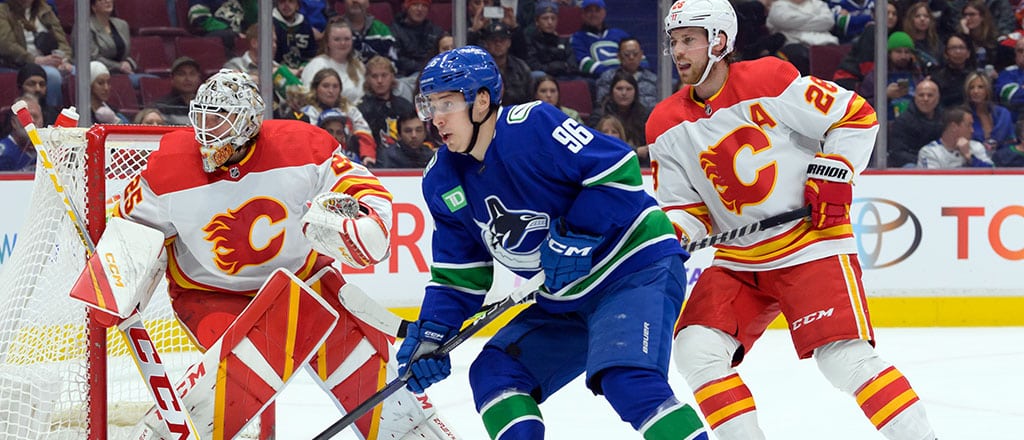
Nothing rocks the core of a league’s fanbase like a big trade out of nowhere, and the National Hockey League saw that foundation rumble Wednesday night as word came out that the Vancouver Canucks and Calgary Flames finalized a deal that should further shift the Western Conference landscape.
The Canucks received forward Elias Lindholm, who was considered one of the top available assets ahead of the 2024 NHL trade deadline. The Flames received a package of forward Andrei Kuzmenko, defensive prospects Hunter Brzustewicz and Joni Jurmo, and a pair of draft picks – a guaranteed first-round pick in the 2024 draft, and a fourth-round pick that could elevate to a third-round pick.
Canucks to win the Pacific Division

-150
Why the Canucks traded for Lindholm
In hindsight, the biggest tells are always right under your nose, so when Canucks president Jim Rutherford went on TSN 1050’s Overdrive and said “We may not even wait until after the All-Star Break” to make a move, we probably should’ve taken his word for it.
The Canucks are having a spectacularly successful year, above even the optimistic expectations of the front office, who felt a playoff spot was achievable if “everything goes right“. Heading into the All-Star Break, the Canucks aren’t just in a playoff spot, but in first overall, with the league’s best goal differential. Some debate exists as to how legitimate and sustainable this is, with the Canucks being largely buoyed by the league’s top shooting percentage and fourth-best save percentage at 5-on-5, combined with underlying shot metrics that are closer to the upper-middle.
With that said, upper-middle is still more than many of us expected (not to mention, is a ranking that’s been in an upward trend), and a 17-point edge over Wildcard 2 with 32 games remaining is a lot of buffer room bought for regression. It seems likely that the Canucks are finally on the right track after years of chaos, and with that in mind, it makes sense that they’d like to take advantage of a year where their megastars (Quinn Hughes and Elias Pettersson), secondary stars (Brock Boeser, J.T. Miller) and elite goaltender (Thatcher Demko) are all finding success.
In Lindholm, the Canucks address their biggest need if they want to continue to make a push. In him, they land a centre who can take on matchup or shutdown minutes while still contributing offensively, and some utility on nights where that isn’t as necessary. Ideally, you want to keep Elias Pettersson free to push the play offensively (or even pivot back to the wing), and while J.T. Miller has had a much better year than those previous in terms of off-puck play, he isn’t a shutdown player.
Lindholm has been a steady two-way threat for the past few years, earning Selke Trophy votes in four of the last five years, including a runner-up performance in 2021/22. One concern is that he’s having a particularly poor year in terms of production, pacing out to a 53-point clip after 64 and 82-point runs in the previous two seasons, though it should be noted that his 6.9% shooting percentage is five points below his career average of 12.1%, and while his on-ice goal differential is on pace to be his lowest since 2016, his goaltenders have had a .896 save percentage with him on the ice this year – hardly helpful. It’s unlikely that the Canucks are going to get Peak Lindholm over these next few months, but they’re betting that he’s somewhere between that and his results so far and that banks them some flexibility, be it in creating a matchup line for him or sliding one of Pettersson or Miller to the wing to free up some responsibility.
The move also frees up some contract space for next year, with Kuzmenko’s $5.5 million off of the books. Whether the Canucks use it to extend Lindholm or commit to someone else remains to be seen.
Why the Calgary Flames traded for Kuzmenko +
As hinted above, Andrei Kuzmenko has, in a short period, gone from a hugely positive asset to a negative one. While the Canucks’ original bet on bringing Kuzmenko to North America was a huge win for the organization, committing to him when they did was a mistake. Hindsight has made it worse, but the warning signs were available at the time as well. Kuzmenko had a monster season as a 26-year-old rookie, putting up 39 goals and 74 points in 81 games, but also shot at a completely unreasonable 27.3%, scoring his goals on just 143 shots. Vancouver’s shooting percentage with him on the ice was over 14%, allowing him to keep a positive plus-minus despite getting .877 goaltending behind him. The Canucks, nowhere near first place or even the playoffs at this time last year, should have been looking to move him for a haul to a team that would be attracted by an entry-level contract. Instead, they paid for the production, giving him a two-year contract extension at $5.5 million per year.
A year on, Kuzmenko has not fit at all with Rick Tocchet’s program, occasionally finding himself stapled to the bench if not scratched outright. The production has not held either – his 21 points in 43 games are pretty respectable when you remember that he’s averaging just 14:21 a night of ice time, but are a far cry from his previous season and his pay grade.
Like Vancouver with Lindholm, Calgary hopes that a change of scenery will be beneficial for the Russian winger. They also aren’t overly committed to him if he doesn’t, as his current contract ends after next year. It allows them to see what they have in the player, and they can move him on more flexible terms next season if it’s not something they like – or in the next few weeks if they don’t see a fit before the March 8th trade deadline.
Since Kuzmenko’s value is somewhere between zero and slightly negative right now, more assets had to be included in this deal, and that might be the meat of it for Calgary. A first-round pick guarantees them some decent draft capital for this summer, and there’s a lot of reason for them to be curious about defenceman Hunter Brzustewicz, who is the main prospect in this deal. Brzustewicz was drafted by the Canucks in the third round of last year’s draft and has been one of the biggest risers since, in large part due to his whopping 69 points in 47 games in his year-to-date with the Kitchener Rangers. His points total ranks first among OHL defencemen, and third overall. The debate here ultimately comes to whether or not his production is an outlier or a leap in progression. If it’s the former, the Canucks sell high on a b-tier prospect. If it’s the latter, the Flames landed a premium asset. Both teams seem willing to take the risk in their own way.
As well, Calgary gets a longshot ticket in Joni Jurmo, a 6-foot-5 defender who the Canucks drafted in 2020. He’s currently playing his fourth pro season in the Finnish Liiga, and the Flames can either keep him there or look to bring him over to the AHL to continue his development with the Wranglers. He’s yet to sign an entry-level deal, so it’ll be interesting to see which route they decide on.
Flames to make the 2023/24 Stanley Cup Playoffs

YES +450
NO -700
What comes next?
With this trade, both sides essentially plant their flags towards their direction for the rest of the year.
For the Canucks, this means going for it. Entering Wednesday, they were tied with Boston for the second-shortest odds to win the Stanley Cup at +850, and that remains the case for the time being. They also sit at -150 to win the Pacific Division in the regular season and have the second-shortest odds of winning the Presidents’ Trophy at +350.
For the Flames, the team isn’t that far out of the playoff picture right now, trailing the second wild-card spot by just five points with plenty of time to recover. Much of their struggle has come from a 2-7-1 start in the first month of the year, and a few of their bigger names are starting to produce with a bit more regularity. All the same, they see the writing on the wall here, and know that even if the team squeaks in, they’re not likely to go very far. They’ll likely continue to sell, and as such, they sit at -700 to miss the playoffs. I don’t know that that’s amazing value, but I do think it’s a realistic end outcome for them.
Interestingly, these two teams may make yet another trade with each other before the deadline arrives, having already made this deal and one involving Nikita Zadorov earlier in the year. Several insiders have reported that Calgary defenceman Chris Tanev was also included in both trade conversations and that both he and the Canucks have an interest in each other – something I’ve also heard through the grapevine. Tanev, a 34-year-old on the last year of his current contract, spent the beginning and prime of his career with the Canucks, and they could use some more defensive depth, making this reunion make a lot of sense. The barrier appears to be a high price tag from the Flames, leaving both sides in a months-long game of chicken. We’ll see in the next few weeks if either gets the leg up on the other in time for a move to happen.
Canucks to win the 2024 Stanley Cup

+850